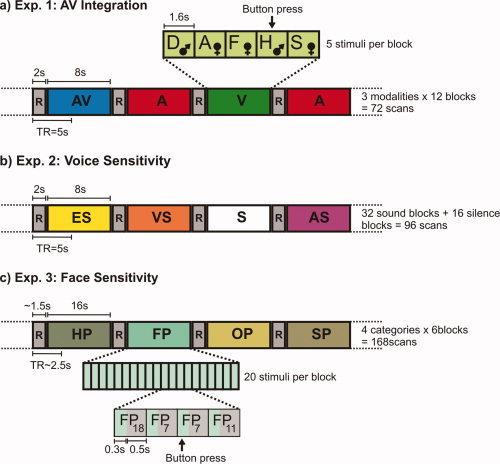Figure 1.

Experimental design. (a) Audiovisual integration experiment. Thirty‐six overall stimulation blocks from three modalities (A, V, and AV) with five stimuli per block were presented in a random order with the restriction that there could not be more than two adjoining blocks from one modality and interleaved with 2 s of rest (R). Stimulus material was randomized across the blocks with the restriction that blocks were balanced for emotional categories. Stimulus presentation within blocks was randomized (D = disgust, A = anger, F = fear, H = happiness, S = sadness; the two remaining emotional categories are not presented within the exemplified block). The task was to press a button when the second “male” (♂) (i.e. male voice, or male face, or both) stimulus within a block was identified. (b) Voice sensitivity experiment. Thirty‐two sound blocks (ES = environmental sounds, VS = vocal sounds, AS = animal sounds) and 16 blocks of silence (S) were presented in randomized order with the restriction that there were no adjoining silence blocks. Blocks were separated by 2‐s periods of rest (R). (c) Face sensitivity experiment. Pictures from four different categories (HP = house pictures, FP = face pictures, OP = object pictures, SP = scene pictures) were presented in 24 blocks. Each block contained 20 pictures, each of which was presented for 300 ms followed by 500 ms of fixation. Stimulus presentation was randomized within blocks. The order of blocks was randomized with the restriction that there could not be adjoining blocks from the same stimulus category. Blocks were separated by ∼1.5 s of rest (R). The task was to press a button whenever a picture was directly repeated (twice per block), exemplified here in the doubling of FP7. [Color figure can be viewed in the online issue, which is available at www.interscience.wiley.com.]
